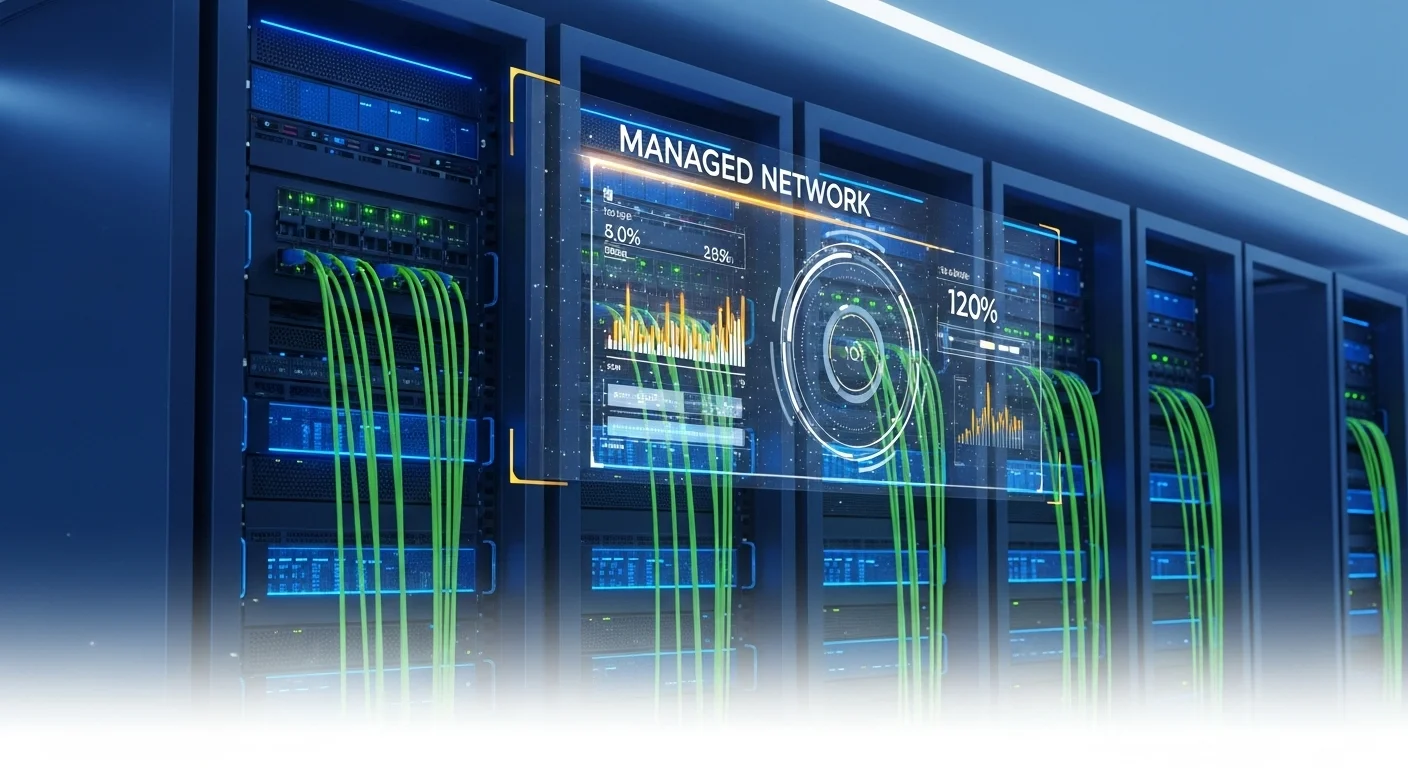Managed Networks: My Guide to Boosting Your Business's Security and Efficiency

Executive Summary
In my years as a network strategist, I've seen countless businesses struggle with the same problem: their IT network, instead of being a powerful asset, becomes a constant source of stress. It's the digital foundation of everything they do, yet it's complex, expensive to maintain, and a prime target for sophisticated cybersecurity. This is where I've seen managed network services make a world of difference. Think of it as handing over the keys to a team of dedicated experts whose sole job is to keep your network running flawlessly, 24/7. This article is my personal guide to understanding this technology. We'll explore how this partnership goes beyond simple IT support, covering everything from proactive maintenance to sophisticated cybersecurity. By letting a Managed Service Provider (MSP) handle the technical headaches, companies save money, tighten their security, and gain the freedom to scale. It frees up your internal team to innovate and drive the business forward, which is where their real value lies. Whether you're a small business trying to compete with the big players or a large enterprise with a complex setup, a managed network is your path to operating smarter, not harder.
Table of Contents
- What is a Managed Network and Why is it Crucial Today?
- The Shift from In-House IT to Managed Services
- The Core Benefits of Managed Network Technology
- A Practical Guide to Managed Network Solutions
- The Technical Nuts and Bolts of a Managed Service
- Business Strategy: Managed Services vs. In-House IT
- Finding the Right Partner and Resources
- Tips and Strategies to Maximize Your Managed Network
- How to Choose the Right Managed Service Provider
- Building a Successful Partnership: Best Practices
- Future-Proofing Your Network with Emerging Tech
What is a Managed Network and Why is it Crucial Today?
In today's business world, your network isn't just a piece of technology; it's the lifeline for all your digital operations. Simply put, a Managed Network is a service where you entrust the monitoring, management, and maintenance of your IT network to a specialized third-party partner, often called a Managed Service Provider (MSP). I always tell my clients this isn't just outsourcing a task; it's forming a strategic partnership. It’s about ensuring your network is not just working, but is also secure, efficient, and ready to grow with your business. Instead of placing the heavy burden of daily network oversight on your in-house team, a managed service gives you access to a dedicated team of experts and advanced tools, often for less than the cost of hiring a single new engineer. The need for this model has exploded because modern networks are incredibly complex. They're no longer confined to one office. We're now dealing with a mix of on-site data centers, cloud services, countless Internet of Things (IoT) devices, and employees connecting from all over the world. Keeping this intricate web running smoothly and securely requires a level of expertise and constant attention that many businesses just can't sustain on their own.
The Shift from In-House IT to Managed Services
I remember when nearly every company had its own in-house IT team handling everything from router setups to server patches. While having that direct control seems appealing, I've seen the challenges firsthand. Small and mid-sized businesses often can't afford a full team of specialists who know the ins and outs of every networking and security discipline. Even large corporations find their IT teams are so busy with 'keeping the lights on' that they have no time for strategic projects that actually grow the business. Then came the relentless rise of cyber threats, which changed the game completely. Suddenly, network security management wasn't just about having a firewall; it demanded a complex, layered defense strategy. For many companies I worked with, trying to build this internally became a huge financial and operational drain. This is what paved the way for specialized, outsourced solutions. The market for managed network security services was born from this need, giving businesses access to top-tier security technology and know-how without the massive upfront investment. A good MSP provides a holistic service that combines network performance with protection—a practice known as comprehensive network and security management. This approach ensures security is built into the network from the ground up, which is absolutely essential for preventing data breaches and meeting compliance regulations.
The Core Benefits of Managed Network Technology
When a company partners with an MSP for its network, the benefits ripple through the entire organization. I've seen it transform operations time and time again.
1. Cost Savings and Predictable Budgets: This is often the first thing that gets a CFO's attention. Building an in-house team is expensive—salaries, training, benefits, plus the cost of advanced tools. Managed services change that unpredictable capital expense into a fixed, predictable monthly operational cost. This makes budgeting so much easier and almost always leads to a lower total cost of ownership in the long run.
2. Access to World-Class Experts: MSPs employ teams of certified pros with deep knowledge across countless technologies. Think of it as having a team of Cisco-certified architects, cybersecurity analysts, and cloud specialists on your payroll, but you only pay for a fraction of their time. It gives smaller businesses a level of expertise that was once only available to large enterprises.
3. Seriously Enhanced Security and Compliance: In today's climate, you can't afford to be lax on security. A key part of an MSP's job is network security risk management. They deploy sophisticated tools like firewalls, intrusion detection systems, and encryption to protect your data. They also perform regular security audits to find and fix weaknesses before they can be exploited. For businesses in regulated fields like healthcare or finance, an MSP is invaluable for ensuring you meet all compliance standards, helping you avoid huge fines. This is the heart of true enterprise network security management.
4. Proactive, Not Reactive, Support: One of the biggest shifts I see is moving from firefighting to fire prevention. Managed services are proactive. They use advanced tools to monitor your network's health 24/7. This allows them to spot and fix potential problems—like a failing piece of hardware or a bandwidth issue—before it causes downtime and disrupts your business.
5. Scalability on Demand: Your business isn't static, and your network shouldn't be either. Managed services are built to be flexible. Need to open a new office, support more remote workers, or roll out a new cloud app? An MSP can scale your network resources up or down quickly. This agility is a massive competitive advantage compared to the slow, costly process of scaling an in-house operation.
6. A Laser Focus on Your Core Business: By offloading the technical grind of network management, you free up your internal team to focus on what truly matters: growing the business. Your IT staff can shift from being reactive problem-solvers to proactive innovators, working on projects that create revenue and improve the customer experience. This strategic shift is perhaps the most powerful transformation a managed network partner can bring.

A Practical Guide to Managed Network Solutions
Diving into the world of managed networks is like discovering a finely tuned engine designed for performance and reliability. To truly get the most out of a Managed Service Provider (MSP), you need to understand the moving parts. I've put together this guide to walk you through the technical methods, business strategies, and resources that make up a top-tier managed network solution, and how it stacks up against traditional in-house IT.
The Technical Nuts and Bolts of a Managed Service
A managed network isn't a single product; it's a flexible suite of services that a good MSP will tailor to your specific business needs. Here are the core components I always look for.
1. 24/7/365 Proactive Monitoring: This is the bedrock of the service. An MSP uses sophisticated tools to keep a constant eye on every part of your network—routers, switches, firewalls, you name it. They're tracking performance metrics like CPU load, bandwidth use, and uptime. The moment a metric looks off, an alert is triggered, and their Network Operations Center (NOC) team starts investigating. In my experience, this proactive approach is what prevents most major outages.
2. Performance and Fault Management: When an issue does pop up, the MSP's team is on it immediately. They dig into the data to find the root cause, whether it's a failing piece of hardware or a simple configuration error. The goal is always to fix it fast, often before your employees even notice there was a problem. This is all backed by a Service Level Agreement (SLA), which is your written guarantee for response and resolution times.
3. Configuration and Change Management: Networks are always changing. You might need a new firewall rule or a reconfigured network segment. An MSP handles all of this, ensuring every change is documented, tested, and implemented correctly to avoid creating new issues. This disciplined approach is a critical part of effective network and security management, as so many vulnerabilities come from simple misconfigurations.
4. Managed Network Security Services: In my opinion, this is the most vital component today. It's a whole suite of protections:
- Managed Firewall: Expert configuration and ongoing monitoring of your digital gatekeeper.
- Intrusion Detection/Prevention: Systems that watch for suspicious activity and can automatically block threats.
- VPN Management: Ensuring your remote team and branch offices can connect to the corporate network securely.
- Content Filtering: Protecting your team by blocking access to malicious or inappropriate websites.
- Patch Management: This is a big one. It's the process of making sure all your network gear is updated with the latest security patches to close known loopholes. This is what modern managed network security services are all about—a layered defense against cyber threats.
5. SD-WAN and Bandwidth Management: For any business with more than one location, managing the connections between them (the WAN) is key. Software-Defined WAN (SD-WAN) is a game-changing technology that intelligently routes traffic to ensure your most critical applications always get the bandwidth they need. An MSP can design, deploy, and manage an SD-WAN solution that improves performance and often cuts your telecom costs.
Business Strategy: Managed Services vs. In-House IT
Choosing between a managed service and an in-house team comes down to a strategic look at cost, skills, and business focus.
Cost Structure:
- In-House IT: You're looking at large, upfront capital costs for hardware and software, plus the ongoing operational costs of salaries and training. It's often unpredictable—costs can spike when equipment fails.
- Managed Services: It's a predictable, fixed monthly operational cost. This makes budgeting a dream. The MSP can offer a lower total cost because they benefit from economies of scale, spreading the cost of their expert staff and expensive tools across all their clients.
Skillset and Expertise:
- In-House IT: Your team's expertise is limited to who you have on staff. It's incredibly expensive and difficult to keep everyone trained on the latest cloud security, AI tools, and other emerging tech.
- Managed Services: You get immediate access to a deep bench of specialists. Their teams deal with diverse challenges every day, building a wealth of experience that's nearly impossible for an in-house team to match, especially in complex areas like enterprise network security management.
Strategic Focus:
- In-House IT: I often see these teams stuck in a reactive mode, constantly putting out fires and handling day-to-day issues. There's little time left for strategic planning.
- Managed Services: By taking over the daily operational grind, an MSP elevates your in-house team. They can finally focus on long-term, strategic projects that use technology to drive business growth.
Network Security Risk Management:
- In-House IT: It can be a real struggle to keep up with the fast-moving world of cyber threats and compliance rules. A single oversight can be catastrophic.
- Managed Services: Security is their bread and butter. They have dedicated security teams and use advanced tools to perform continuous network security risk management. From my experience, they are far better equipped to identify and neutralize risks, giving you a much stronger defense.
Finding the Right Partner and Resources
When you're ready to explore a managed network, there are plenty of resources. Many MSPs offer a free network assessment, which is a great way to get an expert opinion on your current setup. Industry reports from firms like Gartner can provide unbiased comparisons of different providers. And don't underestimate the power of case studies and client testimonials; they give you a real-world look at an MSP's capabilities. The key is to be thorough in your search to find a partner whose skills and vision align with your business goals. A managed network is more than just an IT service; it's a strategic partnership that provides the secure, reliable, and scalable foundation your business needs to succeed.

Tips and Strategies to Maximize Your Managed Network
Making the switch to a managed network is a game-changing move. But to get the absolute best return on that investment, the work doesn't stop when you sign the contract. Over the years, I've seen that the most successful transitions come from careful partner selection, building a strong collaborative relationship, and keeping an eye on the future. Here are my personal tips and best practices for improving your technology experience.
How to Choose the Right Managed Service Provider: A Strategic Checklist
Choosing the right partner is the most critical step. Your entire managed network experience depends on it. Here's a checklist I always advise my clients to use.
1. Verify Their Technical Chops: Don't just take their word for it. Ask about their team's certifications (like Cisco, CompTIA, or CISSP for security). More importantly, do they have proven experience in your industry?
2. Read the Fine Print on the SLA: The Service Level Agreement (SLA) is your contract, and it needs to be crystal clear. It should spell out exactly what services are covered, guaranteed uptime, response times for different issues, and what happens if they don't meet those guarantees. A vague SLA is a major red flag.
3. Deep Dive into Their Security Practices: Security should be at the top of your list. I always press providers on their approach to network security management. Ask about the specific tools they use, what their incident response plan looks like, and how they protect your data. A mature MSP will have robust internal security and won't hesitate to show you documentation. Their skill in network security risk management is what will protect your business.
4. Ask for and Check References: This is non-negotiable. Talk to their current clients, especially businesses that are similar to yours in size and industry. Ask them about the MSP's communication, proactivity, and quality of support. A real conversation with a customer is often more insightful than any sales presentation.
5. Understand Their Tech Stack: What tools are they using for monitoring and security? Are they industry-leading platforms or some proprietary software you've never heard of? You don't need to be an expert, but knowing they invest in quality tools tells you a lot about their commitment to providing a quality service.
6. Make Sure They Can Grow With You: Your business isn't going to stand still, and your MSP needs to be able to support your future growth. Discuss how they scale their services. Ask them about their technology roadmap and how they're preparing for trends like AI and SASE. A forward-thinking partner is a future-proof partner.
Building a Successful Partnership: Best Practices
After you've picked your provider, you need to nurture the relationship. This is how you get long-term value.
- Set Up Clear Communication: Designate a main point of contact on your team and understand who to talk to at the MSP. I highly recommend scheduling regular review meetings, like a quarterly business review, to go over performance, look at security reports, and plan for the future.
- Treat Them Like a Partner, Not a Vendor: The best relationships I've seen are true collaborations. Keep your MSP in the loop about your business goals and challenges. The more they understand where you're headed, the better they can tailor their advice and services. This turns a simple service into a powerful partnership focused on integrated network and security management.
- Empower Your In-House Team: With the MSP handling the daily grind, your IT team is free to focus on high-value work. Encourage them to collaborate with the MSP on strategic projects, like a cloud migration or developing a long-term technology roadmap that supports your business objectives.
- Trust, but Verify: You're outsourcing the tasks, not the responsibility. Make a habit of reviewing the reports your MSP provides. Stay informed about your network's health, the threats they've blocked, and performance trends. This keeps you in the loop and holds your partner accountable.
Future-Proofing Your Network with Emerging Tech
Network management is always evolving. A great MSP will not only manage what you have today but will also guide you toward new technologies that give you a competitive edge.
- AIOps (Artificial Intelligence for IT Operations): AI is transforming this space. AIOps tools can analyze huge amounts of network data to predict problems before they happen, automate common tasks, and spot subtle security threats a human might miss. This leads to a smarter, more resilient network.
- SASE (Secure Access Service Edge): This is a newer model that combines networking and a full suite of managed network security services into a single cloud-based service. It's perfect for modern businesses with remote workers and cloud apps, providing secure, fast access for any user, anywhere.
- Zero Trust Network Access (ZTNA): A cornerstone of modern enterprise network security management, ZTNA works on a simple but powerful principle: 'never trust, always verify.' Instead of giving users broad access to the network, it requires strict verification for every single attempt to access a resource. This dramatically shrinks your attack surface and contains threats if a breach does occur.
By following these strategies, you can turn your managed network into a powerful engine for your business. A well-chosen and well-managed partnership will not only keep things running smoothly but will provide the security and agility you need to thrive in the digital age.
Expert Reviews & Testimonials
Sarah Johnson, Business Owner ⭐⭐⭐⭐
This was a really clear breakdown. As a business owner, the comparison between in-house IT costs and the predictable managed service model was exactly what I needed to see. Very helpful.
Mike Chen, IT Consultant ⭐⭐⭐⭐⭐
Fantastic article. The section on choosing the right MSP with the checklist is spot on. I'll be sharing this with my clients. It simplifies a complex topic without losing the important technical details.
Emma Davis, Tech Expert ⭐⭐⭐⭐⭐
Excellent and comprehensive guide! I especially appreciated the simple explanations of emerging tech like SASE and ZTNA. It's well-written, personal, and packed with valuable insights. Perfect for my research.



